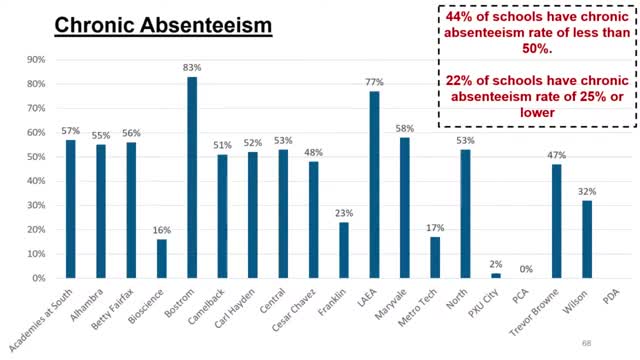Arizona schools face chronic absenteeism crisis
July 09, 2024 | Phoenix Union High School District (4286), School Districts, Arizona

This article was created by AI summarizing key points discussed. AI makes mistakes, so for full details and context, please refer to the video of the full meeting. Please report any errors so we can fix them. Report an error »

During a recent government meeting, officials addressed pressing issues surrounding chronic absenteeism in Arizona schools, highlighting a concerning trend that has worsened since the COVID-19 pandemic. The discussion centered on the need for more inclusive metrics to assess attendance across all schools rather than relying on district-wide averages, which can obscure the challenges faced by individual institutions.
A statewide interactive map was introduced, showcasing chronic absenteeism rates across various districts. The data revealed alarming figures, with some districts reporting absenteeism rates as high as 50%. Officials noted that while absenteeism is a national epidemic, Arizona's situation is particularly severe, with elementary school absenteeism rates now mirroring those of high schools—a shift from previous trends where high school students were more affected.
The meeting also touched on the disproportionate impact of suspensions on students of color, particularly Black students, who are significantly more likely to face out-of-school suspensions compared to their white peers. This raises concerns about the intersection of attendance and disciplinary actions, prompting calls for a deeper analysis of absenteeism by student subgroup to better understand the underlying issues.
In addition to attendance, the conversation shifted to staff retention, which appears to be relatively stable compared to national trends. However, concerns were raised about the need for monitoring staff attendance and addressing the ongoing teacher shortage. The retention of teachers of color was emphasized as a critical area for improvement, with suggestions for developing programs to support and recruit a more diverse teaching workforce that reflects the student population.
Overall, the meeting underscored the urgency of addressing chronic absenteeism and its broader implications for student well-being and educational equity. Officials expressed a commitment to developing targeted strategies and metrics to tackle these challenges, recognizing that the future of Arizona's education system hinges on the engagement and success of all students.
A statewide interactive map was introduced, showcasing chronic absenteeism rates across various districts. The data revealed alarming figures, with some districts reporting absenteeism rates as high as 50%. Officials noted that while absenteeism is a national epidemic, Arizona's situation is particularly severe, with elementary school absenteeism rates now mirroring those of high schools—a shift from previous trends where high school students were more affected.
The meeting also touched on the disproportionate impact of suspensions on students of color, particularly Black students, who are significantly more likely to face out-of-school suspensions compared to their white peers. This raises concerns about the intersection of attendance and disciplinary actions, prompting calls for a deeper analysis of absenteeism by student subgroup to better understand the underlying issues.
In addition to attendance, the conversation shifted to staff retention, which appears to be relatively stable compared to national trends. However, concerns were raised about the need for monitoring staff attendance and addressing the ongoing teacher shortage. The retention of teachers of color was emphasized as a critical area for improvement, with suggestions for developing programs to support and recruit a more diverse teaching workforce that reflects the student population.
Overall, the meeting underscored the urgency of addressing chronic absenteeism and its broader implications for student well-being and educational equity. Officials expressed a commitment to developing targeted strategies and metrics to tackle these challenges, recognizing that the future of Arizona's education system hinges on the engagement and success of all students.
View full meeting
This article is based on a recent meeting—watch the full video and explore the complete transcript for deeper insights into the discussion.
View full meeting
